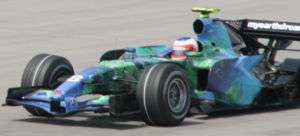Environmentalism in motorsport
The issue of environmentalism in motorsport surrounds the whole of auto racing to reduce its carbon dioxide emissions contributing to global warming.
.jpg)
Initial reception
The first series to respond to the call to make motorsport more environmentally friendly was the International Formula Master series, who planned to use a petrol–electric hybrid and regenerative braking systems in their cars for the 2007 season.[1] A month later the series announces that it will not use the hybrid system for the 2007 season and instead opt for regular fuel.[1] Meanwhile, Audi's diesel-powered R10 had won the American Le Mans Series by a margin of almost 100 points from their nearest rivals.[1] In the United Kingdom, British Touring Car Championship team West Surrey Racing (WSR) ran Rob Collard and Colin Turkington in Ethanol fueled MG ZSs.[1]
New championships
.jpg)
Formula E
In 2012, the Fédération Internationale de l'Automobile (FIA) announced that they would be the governing body for a new fully electric single seater championship. The series would be known as the FIA Formula E Championship and began in September 2014.[2] In 2018, the second generation of Formula E cars was used for the first time, at the start of the 2018–19 Formula E season. The series is participated in by multiple manufacturers, including Jaguar, Audi, Nissan, BMW and Mahindra.[3]
Actions taken in other series
Formula One

Formula One's governing body, the FIA, took until May 2007 to act upon the issue of environmental effects the sport was responsible for by holding a discussion in Monaco during the Grand Prix.[4] The Honda Works Team however, announced that they would run a sponsorless car for the 2007 season three months prior to the FIA's Monaco discussion. The Honda RA107 took on a livery that depicts the Earth, symbolizing Honda's environmental desires, with only the logos of Type R Honda 'H' and the Bridgestone logo.
The car mostly received a cynical reception, Red Bull Racing's Mark Webber observed that "it's good Honda is going green - but there are still 35 private jets parked 20 Kilometres down the road."[5] Briggs commented that "Honda's 'Earth Car' may have attracted cynicism, but the issues it highlights are moving up motorsport's agenda."[4]
In 2013, the FIA made plans to switch from V8 engines to turbo charged V6 engines,[4] after the previous downgrade from V10 engines to V8 engines in 2006.
In 2009, the sport introduced kinetic energy recovery. Following a brief ban, these systems were reintroduced in 2011, these technical regulations were further revised for 2014 (see above).
North American motorsport
IndyCar was the first major open wheel series to reduce its green house gases by changing its fuel supply from methanol to more environmentally friendly ethanol fuel for the 2007 season.[6]
Sportscar racing
Both the Le Mans Series and American Le Mans Series have made some effort to be more environmentally friendly. Both Audi and Peugeot have made diesel race cars, the R10 TDI and 908 HDi FAP respectively, for their series. Both also competed in the 2007 24 Hours of Le Mans where both cars competed for the win which resulted in the German manufacturer coming out on top.
In the British GT Championship, a diesel-powered Aston Martin DBRS9 made series history by winning at the Snetterton round.
Since 2011 (Audi and Toyota in 2012, Porsche in 2014, then by Nissan at Le Mans in 2014), the top class of sports car racing, LMP1, has seen hybrid powertrains.
In 2012, Drayson Racing introduced the Lola B12 69/E: a modified a Lola prototype chassis,[7][8][9] and set a world record for electric cars in 2013.[10]
In 2019, ACO has announced Mission H24 to bring hydrogen-powered racing car to 24 Hours of Le Mans in 2024.[11]
The Vw IDr has set various records in 2018 and 2019.
Touring car and European open wheel racing
As well as WSR's efforts, Paul O'Neill also entered a privateer entry in the BTCC, racing a bioethanol-powered Vauxhall Astra at the Brands Hatch meeting of the 2006 season. Soon, environmentally friendly entrants span to the World Championship stage with Alfa Romeo unveiling a diesel-powered entry for the 2007 season, which would make them the first manufacturer to enter a diesel-powered car in the World Championship. In April 2007, Swede Robert Dahlgren won the opening round of the Swedish Touring Car Championship in a bioethanol-powered Volvo S60.
European open wheel championships also made efforts to go greener, the British Formula Ford championship considered changing to bioethanol fuel for the 2007 season in December 2006 although three months later the series moved the plans to the 2008 season.[6] In July 2007, the World Series by Renault became the first major European open wheel series to announce a move to biofuel, the new car will be used for the 2008 season.[4]
See also
- KERS
- Formula Zero
- FIA Formula E Championship
- TT Zero
- TTXGP
- FIM MotoE
References
- Motorsport's Green Future, Autosport magazine, Vol. 189, No. 4, Pg. 76, Haymarket Publications. 26 July 2007
- Telegraph Sport (13 September 2014). "Formula E opens with spectacular crash involving Nick Heidfeld and Nicolas Prost as Lucas di Grassi claims win". The Daily Telegraph. Retrieved 13 September 2014.
- "Championship Overview". fiaformula.com. Retrieved 22 April 2019.
- Motorsport's Green Future, Autosport magazine, Vol. 189, No. 4, Pg. 79, Haymarket Publications. 26 July 2007
- The Big Questions of 2007, Autosport magazine, Vol. 187, No. 11, Pg. 38, Haymarket Publications. 15 March 2007
- Motorsport's Green Future, Autosport magazine, Vol. 189, No. 4, Pg. 77, Haymarket Publications. 26 July 2007
- http://www.idtechex.com/research/articles/lola-drayson-all-electric-le-mans-prototype-00003852.ja.asp?donotredirect=true&setlang=ja
- http://www.materialstoday.com/composite-applications/news/lola-drayson-electric-race-car-employs-green/
- http://www.theengineer.co.uk/issues/january-2012-online/lola-drayson-electric-racing-car-unveiled/
- http://www.digitaltrends.com/cars/drayson-racing-sets-electric-car-speed-record/
- Lloyd, Daniel. "ACO, GreenGT Launch 'Mission H24' Hydrogen Strategy – Sportscar365". sportscar365.com. Retrieved 9 July 2019.